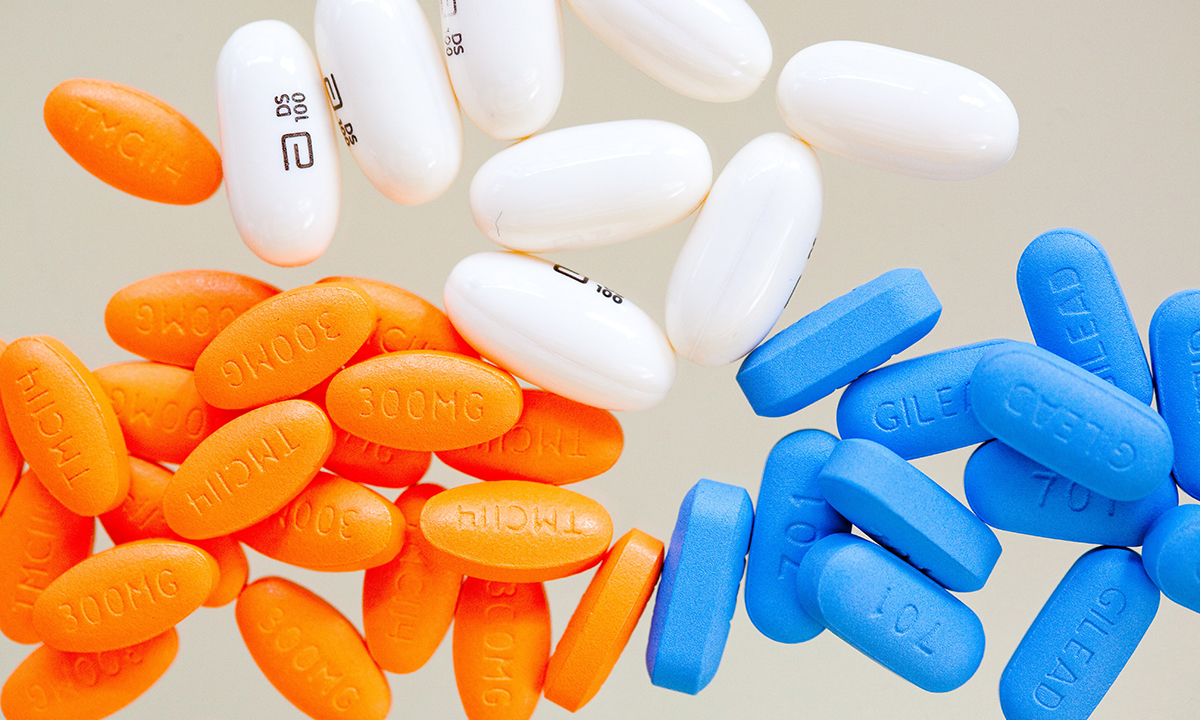MORE than two decades after the life-saving discovery that combining three antiretroviral (ART) drugs could induce and maintain full suppression of HIV replication, new research suggests that many patients could be safely switched to a two-drug regimen with potentially fewer toxicities.
Two identically designed open-label multicentre studies, SWORD-1 and SWORD-2, randomised 1028 patients with HIV suppression to either continue with their existing ART (typically triple therapy) or switch to dual therapy with dolutegravir–rilpivirine.
Published in the Lancet, the industry-funded studies found dual-therapy was non-inferior to usual care over 48 weeks. In both the usual care and the dual-therapy groups, 95% of patients maintained undetectable viral loads (lower than 50 copies per mL), a pooled analysis showed.
Professor Mark Boyd of the University of Adelaide and Professor David Cooper of the University of New South Wales wrote in an accompanying editorial: “These results make a convincing case for the use of dual therapy as a maintenance strategy”.
They added: “The question of whether dual therapy can be used in people with viraemia (either in those patients naive to ART or having had virological failure) remains open”.
They noted that a previous systematic review and meta-analysis found that efficacy did not differ between the use of two- and three-drug ART; however, dual therapy was associated with selection of greater degrees of resistance at virological failure and poorer performance in people with a baseline viral load of more than 100 000 copies per mL.
More than 25 000 Australians live with HIV, and experts say that the majority are successfully treated with triple therapy.
Professor Sharon Lewin, director of the Peter Doherty Institute for Infection and Immunity, a joint venture of the University of Melbourne and Royal Melbourne Hospital, told MJA InSight that the study’s findings were “very exciting” as this was the first large study to clearly show that two drugs could maintain HIV suppression for at least 48 weeks.
Unlike conventional triple therapy, neither drug in the SWORD dual-therapy regimen comes from the commonly-used class known as nucleoside reverse transcriptase inhibitors (NRTIs), which have been associated with long term negative mitochondrial, renal, cardiovascular and bone-health effects.
The SWORD studies found larger reductions in bone-turnover biomarkers among patients who received dual therapy compared with those who received usual care, which the authors said most likely suggested improved bone mineral density after ceasing tenofovir disoproxil fumarate.
Also, although tenofovir has been reported to be a lipid-friendly drug, the study found no negative lipid effects among the patients who switched to dolutegravir–rilpivirine.
Professor Lewin said that the study’s findings would be relevant to about 10–20% of people living with HIV who may not be able to tolerate three-drug ART, either because of resistance to NRTIs or underlying health conditions that meant NRTIs should be avoided.
“We currently have many different ART drugs from which we can tailor a triple therapy combination for each individual, but even still, in about 10% of individuals, there are some toxicities – usually from the NRTIs,” Professor Lewin said.
“These new findings clearly demonstrate that dual therapy with dolutegravir and rilprivirine – both of which are already available in Australia – is an effective alternative for some people living with HIV.”
In the SWORD studies, adverse events leading to withdrawal of treatment occurred in 3% of patients in the intervention group, compared with 1% of those who continued with their usual therapy. Neuropsychiatric adverse events such as insomnia, depression and abnormal dreams were reported more frequently in the intervention groups – all side effects known to be associated with dolutegravir.
The authors concluded: “Once-daily oral dolutegravir–rilpivirine will be the first oral two-drug regimen that provides patients with an alternative to guideline-preferred triple-drug regimens, avoids major NRTI toxicities, has limited potential for drug-drug interactions, and does not increase lipid concentrations or inflammatory biomarkers.”
All patients in the study were 18 years or older, were on their first or second ART regimen and were stably suppressed for 6 months or longer, with no evidence of resistance to the ARTs before switching to dual-therapy.
The studies were performed in high-income countries, with the authors saying it was unclear if the results would be relevant in low-income settings.
Professor Lewin cautioned that dolutegravir–rilpivirine would not be suitable for individuals with hepatitis B, who required the NRTIs tenofovir and lamivudine to specifically treat hepatitis B.
She added that further studies were needed to see if dolutegravir–rilpivirine could reduce long term complications of treatment.
Professor Lewin said there would be no cost difference to Australian patients from switching from triple therapy to dual therapy, as ART is covered by the Section 100 list of highly specialised drugs.
Dolutegravir and rilpivirine are both still on patent. However, other studies are looking at regimens using lamivudine, an off-patent drug. Professor Lewin said that the use of two versus three drugs – particularly off-patent drugs – could massively reduce the cost of treating HIV globally.
As Professors Boyd and Cooper concluded in their editorial: “All in all, 30 years since the emergence of ART, the potential pipeline for a variety of effective dual therapy options appears rich”.
To find a doctor, or a job, to use GP Desktop and Doctors Health, book and track your CPD, and buy textbooks and guidelines, visit doctorportal.

 more_vert
more_vert